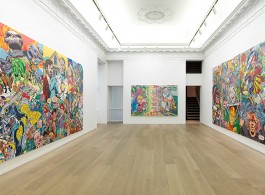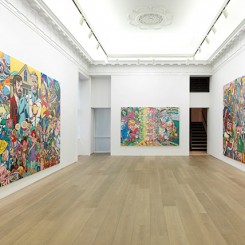ERRÓ
“Paintings from 1959 to 2016”
1 March – 23 April 2016
Opening Reception Tomorrow: Tuesday 1 March, 6-8pm
Galerie Perrotin, New York
Galerie Perrotin, New York is pleased to present the first exhibition dedicated to Icelandic artist Erró (Ólafsvík, 1932), a prominent figure of Pop art and Figuration Narrative in postwar Europe, with an ensemble of 15 paintings made between 1959 and 2016.
As the forefather of painted collage (that is the practice of painting strictly after preparatory montages of ready-made images), Erró has developed since the mid-1950s a satirical and exuberant saga of consumer society and global politics, in which politicians, superheroes, tyrants, aliens, celebrities, warriors and lovers collide. In an essay published in 1999, late American art critic and philosopher Arthur C. Danto concluded: ‘As for the role Erró plays in the history of art, it can be said that he has succeeded, all by himself, in bringing Pop Art into its flamboyant baroque(1)’. That says it all.
After studying classical painting, fresco and mosaic in Oslo, Florence and Ravenna, Erró moved to Paris in 1958, where his friend, artist Jean-Jacques Lebel, introduced him to the Dadaist and Surrealist circles, including Marcel Duchamp, André Breton, Max Ernst, André Masson and, among many others, Roberto Matta, with whom he regularly practiced four-handed drawing. The influence of these artists’ unconventional and fanciful spirit can be seen in his early works and, more specifically, his fascination for the mechanization of humankind at the time. For instance, the oldest painting presented at Galerie Perrotin, “The School of New-Par-Yorkis” (1959, from the series “Le Monde de l’art”), is a vitriolic portrait of Jackson Pollock, who is figured as a dinosaur skeleton dripping onto a canvas in front of another tachist painting, typical of Hans Hartung. Meanwhile, two robot-disciples are shown zealously daubing paint with their telescopic arms and intestine cables in the purest, geometrical and gestural, styles of abstraction.
Firmly believing that ‘painting must be of its time and a reflection of its age’(2), Erró rejected Abstract expressionism and the Paris School, which prevailed in the postwar art world on both sides of the Atlantic. He instead let ready-made images progressively invade his work until his figurative practices of collage and painting merged for good in the early 1960s. Indeed, while he had already transposed some of his collages onto paintings as early as 1959 with his series “Meca-Make-Up”, in which he hybridized human body parts with mechanical components, and rediscovered that radical gesture in 1963 with his series “Ombromanies”, it wasn’t before 1964 during his first trip to New York that he systematized his two-stage compositional technique and left behind his own imaginary representations to resolutely draw on the infinite resources of mass media and pop culture.
Upon his arrival in New York at the turn of 1964 and within a span of only four months, Erró fully immersed himself in the lively avant-garde milieus of the new art capital. He met Robert Rauschenberg and Jasper Johns. He participated in Daniel Spoerri’s “Snare-Pictures” along with Marcel Duchamp, Andy Warhol and Roy Lichtenstein. He frequented the Gramercy Arts Theater, run by Jonas Mekas’ Film-Makers’ Cooperative. He attended Allan Kaprow and Wolf Vostell’s action-lecture “The art of the Happening” at the Cricket Theater and also took part in the latter’s décollage-happening “You” in Great Neck, Long Island. His first American solo exhibition took place before the end of his trip at Gertrude Stein Gallery, which a critic of Art Voices described as the work of a ‘true Pop-Surrealist‘. […]
At Galerie Perrotin, Erró’s chaotic yet incisive visions of the world include “Lovescape” (1973-1974), which spread the love between machines, humans, notably figures borrowed from the history of art, and the whole fauna of the Earth in a phenomenal orgy. Both bucolic and grotesque, this scene is reminiscent of “The Garden of Earthly Delights” by Hieronymus Bosch (circa 1500) and appears at first glance like a monstrous battlefield. In the thick of the Cold War, whereas “Stukas” (1974) bluntly precipitates Nazi dive bombers in Vietnam, other Russian caricatures regarding Western foreign affairs whirl into the vertiginous perspectives of “La Bombe” and “Nato” (both 1977, from the series “L’Ouest vu de l’Est”). ‘Any historical event or armed conflict is accompanied by a war of images. For an artist like me, who uses media images to make collages, the starting points of my paintings, there is no shortage of materials, (4)’ he wrote. Finally in “Sarajevo” (1996, from the series “Target Practice”), which Erró made in reaction to the siege of the capital during the Bosnian War, it is an ethnic conflict between superheroes and villains that actually spreads unspeakable terror among civilians.
As a matter of fact, among the many American references that Erró has used throughout his career, comic characters – especially superheroes – cured his primary obsession with robotics while considerably pervading his art to the point that he even dedicated an entire series to them in the late 1990s, his “Saga of American Comics”. They are the central subject of the allover compositions “Good Morning America”, “Captain America” (both 1992) and “Wonderwoman scape” (1999) at Galerie Perrotin. That said, the artist’s survey continues with a completely different kind of pop icons in more recent paintings, including “Dogman” (2012), which stages the rapper Snoop Dogg with a bulldog and a sheep in shorts, and even more implausibly “Poutine et Miley Cyrus” (2013, from the series “Moscou-Berlin-Paris”), in which the singer twerks while sticking out her notorious tongue next to a topless caricature of the Russian president and Alfred E. Neuman, the mascot of Mad magazine.
Whereas Erró firmly renounced inventing his own imaginary figures to seize instead, voraciously, the inexhaustible iconography spread by mass media for over fifty years now, his paintings have never ceased to demonstrate, ironically, that reality is greatly stranger than fiction. In fact, while masterfully orchestrating through collage the absurdity and violence of our contemporary propagandas, whether political, commercial or cultural, his chaotic and outlandish visions trigger more than delirious impressions. In this regard, Erró’s contribution to Pop art is all the more exceptional that his oeuvre is deeply hallucinatory.
Violaine Boutet de Monvel
On the occasion of the exhibition, a 112 page monograph will be published by Galerie Perrotin and Editions Dilecta including texts by Bartholomew Ryan, Arthur C. Danto, Jean-Hubert Martin and Danielle Kvaran in English and French.
Erró was born in 1932 in Ólafsvík, Iceland, he lives and works in Paris.
Erró recently had his first comprehensive retrospective at Musée d’art contemporain Lyon (2014), and personal exhibitions at the Centre Georges Pompidou, Paris (2010, 1975); Jeu de Paume (1999); Musée d’Art moderne de la Ville de Paris (1985, 1974, 1969); Schirn Kunsthalle Frankfurt (2011); Museum Moderner Kunst Stiftung Ludwig Wien (1996); Randers Kunstmuseum, Danemark (1981); Tel Aviv Museum of Art (1958); The Grey Art Gallery, New York (2004); Museo Nacional de Bellas Artes, La Habana (2004); Reykjavik Art Museum (2015, 2014, 2013, 2012, 2011…). He has participated in numerous group exhibitions : “The world Goes Pop” at Tate Modern (2015); “Picasso.Mania” at Grand Palais, Paris (2015); “International Pop” at the Walker Art Center/Dallas Museum of Art (2015); “Les Désastres de la guerre. 1800-2014” at Louvre Lens (2014); La Biennale de Lyon (2013, 1991); “Big Bang” at Centre Georges Pompidou (2005); “Europop” at Kunsthaus Zurich (2008); “Surrounding Bacon and Warhol” at Astrup Fearnley Museet Oslo / Göteborgs Konstmuseum (2012); “Paris, Capital of the Arts. 1900-1968” at Guggenheim Bilbao / Royal Academy of Arts London ( 2002); “Printed Art Since 1965” at Museum of Modern Art New York (1980).Erró has represented Iceland at the Venice Biennale in 1986.
Erró’s work is included in the following permanent collections ; MoMA New York; The National Gallery of Art, Washington; The British Museum London; Musée du Louvre Paris; MNAM/Centre Pompidou Paris; Musée d’Art moderne de la Ville de Paris; Hara Museum Tokyo; Musée des Beaux Arts de Montréal; National Museum of Modern and Contemporary Art, Séoul; Tel Aviv Museum of Art; MNCA Reina Sofia Madrid; Museu Coleção Berardo Lisbon; Moderna Museet Stockholm; Astrup Fearnley Museet Oslo; Louisiana Museum of Modern Art Humlebaek, Denmark; Kunstmuseum, Bergen; Staatliche Museen zu Berlin; Museum Moderner Kunst Stiftung Ludwig Wien; Rijksmuseum Amsterdam; Musée d’art contemporain Lyon; MACVAL France; Museo Nacional de Bellas Artes de La Habana; Fondation Vincent van Gogh, Arles; Musée Picasso, Antibes; Musée d’art moderne de Lille Métropole….
1. Arthur C. Danto, “Phénoménologie picturale et allégorie politique dans l’art d’Erró”, in Erró, Galerie Nationale du Jeu de Paume, 1999, p. 26.
2. Danielle Kvaran, “Erró, from image to image”, in Erró Retrospective, Musée d’art contemporain de Lyon, 2014, p. 26.
4. Erró, “God Bless Bagdad”, in Erró Retrospective, op. cit., p. 306.


